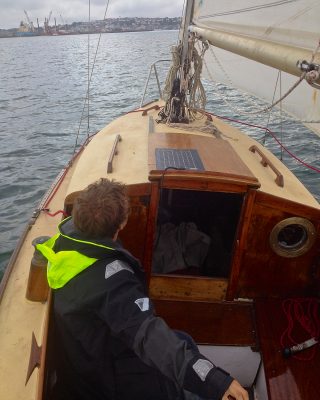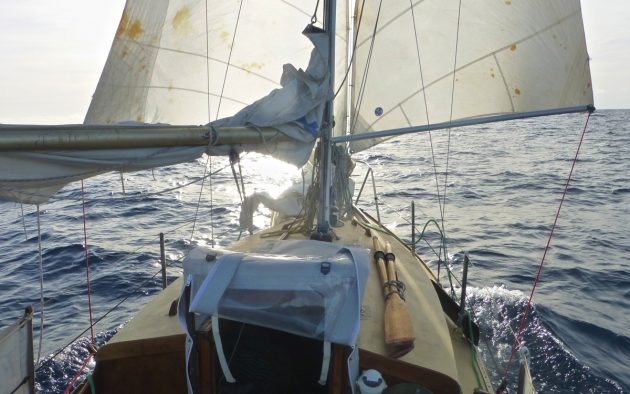To the Atlantic islands
For the first time in my life I left the comfort of the continental shelf, and sailed out into the expanse of the North Atlantic, bound for the Canaries. With the wind in the north, Flying Cloud and I covered between 110 and 130 miles a day under full sail. After three days, the wind gradually veered to the south, and for the following three days we were hard on the wind, making about 80 miles a day.
On the seventh day, the wind backed to the north-east, and Roque del Oeste, a rocky island just off the north-eastern tip of La Graciosa, rose up from the horizon like an apparition. Under poled-out jib, we cruised between Isla de Montaña Clara and La Graciosa, before making landfall on the southern shore of La Graciosa, anchoring off Playa La Francesa.
A lot happened in the Canaries: I encountered the strongest winds of the trip so far and enjoyed some great surfing. I made many new friends, bumped into old friends and even had a romantic encounter of my own. Six weeks later, having crossed over to Gran Canaria, I departed Las Palmas under small jib and double-reefed main, bound for the Cape Verde islands.

The 50-year-old Flying Cloud needed a few improvements before setting off across the ocean
For the first 20 miles, I changed sails repeatedly as wind shadows gave way to short, intense gusts that rolled down from the hills and caused the boat to veer off course, despite the self-steering. Eventually, the breeze settled into a light northerly, so I poled out two genoas and averaged 100 miles for the next three days.
At 25°N, we picked up the tradewinds. The steady Force 3 strengthened to a Force 6-7, building up a big following sea. I steadily reduced sail until under small jib alone, we were still making 6 knots. The wind began to whine in the rigging – it was confusing and not what I imagined the tradewinds were going to be like. I later found out some friends of mine had suffered a knockdown in the same weather system.
The next day the wind dropped slightly to a Force 5-6, but the swell continued to build. I poled out another small headsail, and Flying Cloud reached new top speeds as she surfed down the steep breaking waves. It was a fast passage. We consistently made 120 to 130 miles a day. The Trades were so convenient, it almost felt like cheating.

Flying Cloud making steady progress under poled-out headsails in the tradewinds
Seven days after leaving Las Palmas, and ten miles north of Ilha do Sal, there was still no evidence of land. Dust blown from the Sahara results in a thick haze, smothering the islands from view. Finally, three mountains emerged out of the mist – it was alarming to suddenly see them right there in front of me.
The lunar landscape showed few signs of life. Dry, pockmarked hills rose out of barren, flat areas of orange gravel, with only the occasional desert shrub to break up the emptiness. Then, behind a large stone breakwater, the port of Palmeira appeared, full of brightly painted buildings, cobbled streets and welcoming people.
Cape Verdeans are racially mixed, of European and West African descent, most with golden-brown complexions and sun bleached, tightly curled hair. Almost everyone I met seemed open and warm-hearted, but many struggle to make ends meet economically despite some industry. Oil refineries and commercial shipping were in operation around the harbour, but the town was somewhat blighted by mounds of waste and unfinished buildings.
Two weeks later, having sailed 100 miles west to Mindelo on São Vicente, I filled my lockers with essential sailing provisions, lubricated the self-steering gear, scrubbed below the waterline, and departed for the Caribbean. In the early morning light, we made quick progress in the acceleration zone between the two islands – Santo Antão to the north, and São Vicente – which then appeared to converge in an optical illusion behind us. This was the trip that I had been planning for so long – a dream at first; it felt so good to make it happen.
 For the first few days, I ran with the swell under small jib alone. The waves were the steepest I had yet seen. They were not the long, undulating oceanic mountains that I expected, but short, sharp, white-fringed rollers.
For the first few days, I ran with the swell under small jib alone. The waves were the steepest I had yet seen. They were not the long, undulating oceanic mountains that I expected, but short, sharp, white-fringed rollers.
On the fourth morning, I was relieved as the wind began to ease. I poled out two genoas and tried to accustom myself to the feeling of rolling steadily downwind. Gradually, the compass checks and sail adjustments became fewer and further between as the percussive rhythm of the bow wave became a normal feature of life.
Nighttime brought the phosphorescent plankton, more alive and concentrated than I had ever seen. Flying Cloud’s slipstream transformed into a long, elegant dragon’s tail. Often dolphins and whales would join the convoy, visible as bright-green exoskeletons dancing in the inky black water at the bow.
I always woke in a positive mood; my entire world contained in the tiny space – an ocean separating us from everything else. I developed a routine: scan the horizon, occasionally change the headsails; play music while boiling water on the paraffin stove, then drink tea in the cockpit under the morning sun.
After collecting flying fish off of the deck, I would leave them to marinade in a bowl of lime juice. In the saloon, I would pour water into a transparent jar full of young seedlings – my precious supply of fresh produce.
Finally, I would throw a jelly lure on a heavy line over the transom. Most days something would bite, though often the fish would escape. Sometimes the line would break, but every now and then I managed to get something into the cockpit – mostly yellow fin tuna, sometimes dorado, and often species too exotic for identification. Sometimes I would steer, or carry out little bits of maintenance around the boat; I read nine books, did a lot of guitar practice and listened to music constantly.
As I passed the halfway point, I noticed a few grey clouds in the eastern sky. There had been no rain since the Canaries and as the isolated cluster grew nearer, I could see they were blanketed by a misty haze – quite a contrast to the white, fluffy cumulus clouds I had become so used to seeing. The squall brought an increase in wind and a heavy downpour. In the unfamiliar conditions, I struggled on the foredeck to remove the pole and lash down one of the genoas, but before I had finished, it had passed and I found myself becalmed.

A cosy world afloat – navigating aboard Flying Cloud within reach of the galley
In the following days, the squalls became more and more frequent. In daylight I could spot them on the horizon, dark shapes creeping up from behind like a pack of wolves. I could sense their presence at night too, either by the light rain blowing through the companionway, or the slight increase in wind. Prewarned, I would jump out of the cabin and take in sail, but one squall succeeded in catching me off guard, pulling both the jib and spinnaker halyards out of their blocks at the masthead. Both sails and poles came crashing down to the deck. Lesson well and truly learned.
With each day I felt more comfortable and content. I had taken a step back from civilisation and was able to appreciate how absurd life on land could be. Everything became uncomplicated; I felt the purest joy I had ever known. I was humbled, an insignificant speck in the seemingly endless expanse of the ocean, yet at the same time, I felt like a god, totally in charge of my own world.
After 18 days at sea, I could feel the presence of land looming in the distance. I noticed more seabirds circling around the boat and even saw some commercial shipping. With 200 miles to go I felt on top of the world. In my mind, there was no possibility of not making it, whatever came my way. But I had tempted fate, and now it would punish me with fury.

Max’s Altantic passage was life-changing in more ways than one
While priming the paraffin stove, a flaming bottle of methylated spirit exploded in my hand with a squeaky pop. Barely clothed and covered in flames, searing pain ravaged my face and torso. I rushed outside and held onto a stanchion, grasping for my life as I flipped myself over the side.
Extinguished, I climbed back on board and assessed the damage. My duvet and other items of clothing had caught fire, so I threw a bucket of water down the companionway to douse the flames, but it was obvious that the worst of the damage had been inflicted on my body. Charred pieces of skin fell off my arms, chest, and torso, my face felt stiff, and several big blisters had already formed.
My days of working in the RNLI had prepared me well for this situation, but I never foresaw having to treat myself. I used dressings, creams, antibiotics and painkillers, making myself look more like an Arabian nomad than a sailor.
After 18 days of heaven, I had to endure two final days of hell. On 1 March, I spotted a faint etching of mountainous terrain conflicting with the shades of blue I had become so familiar with – Grenada.

Anchored in Grenada, Flying Cloud awaits the next adventure
My arrival in the Caribbean was not as I had hoped it would be. It was a relief to be back on land, but I felt completely robbed of celebration. I dropped anchor within a stone’s throw of the shore, then struggled to pack the boat away and pump up the dinghy. Two hours later I lay dressed like a mummy in a hospital bed.
The sudden change in circumstance was bewildering, and for a while I was unsure how to move on. Sunshine became my enemy, and it was obvious the Caribbean wasn’t the ideal place for me to be. My priorities had been completely transformed – never had it been so undesirable to live on a small boat. I left Flying Cloud in a hurricane hole, not sure when I would see her next, and flew back to not-so-sunny England.
The burns were superficial, so I remind myself that it was a small setback, and that although it was the end of the journey, it is not the end of the adventure. The more time that passes, the better I am able to overlook the final upheaval, focusing more on the 5,000 miles covered during the first seven amazing months.
I still love adventure and the ocean. Single-handed sailing offers incredible, euphoric joy, and I’m eager for the next voyage.
 About the author
About the author
Max Campbell, 21, began sailing in Bristol Harbour at the age of five, before moving to Falmouth and racing dinghies through his early teens. As well as Optimists and Lasers, he regularly raced Falmouth Working Boats in the Carrick Roads.
In 2015 he bought Flying Cloud, a 22ft Clyst Class sloop, built in 1965 and planked in mahogany on oak. He spent a year restoring her at his stepfather’s boatyard in Mylor Creek, Cornwall, and, after finishing a degree in oceanography, sailed her single-handed to the Caribbean.
UPDATE: Max completed his second transatlantic in 2018, bringing Flying Cloud back to the UK single-handed. You can read his first-person account of sailing from the Caribbean to Europe here.





 About the author
About the author